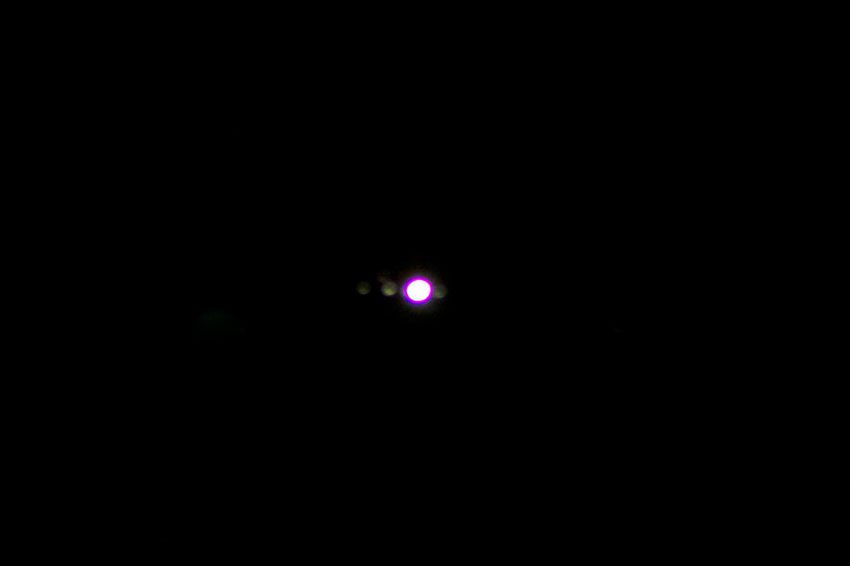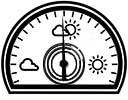Clear Skies at Last – The Moon, Jupiter, Mizar and Alcor
Following the amazing sunset we had yesterday here at Ynyslas I was hopeful that we might finally get a chance to use our new telescope. My optimism was short lived though because as soon as I had I returned from taking a photo of the sunset it started pouring with rain again. They do say that of you don’t like the weather in Wales then wait five minutes, and that rang true last night. As it got dark, the clouds cleared again and what was that in the sky? Was that bright thing the moon, and those other dots stars? They were – We’ve had so much mist and murk since Christmas that I was beginning to think we may be alone in the universe, but no, there were still other worlds up there.
Time to get the telescope out and see what we could see. The telescope we have is a 5.1 inch (130mm) reflector scope with a 900mm focal length. It comes with two eyepieces, and a x2 barlow lens, a motor drive and is mounted on a fairly sturdy Equatorial Mount. Don’t worry, if none of this means a thing to you, it didn’t to me a month or so ago but you soon pick it up. It’s a fairly large, heavy piece of kit and as it’s new I’m treating it very delicately so its a bit of a task to carry it outside but only takes a few seconds and isn’t really too bad.
Last night, all I wanted to do was get to grips with moving it about the sky, check out the various eyepieces and get the red dot finder aligned with the main telescope. The obvious first target therefore was the Moon. It’s big, bright, easy to find, can’t be mistaken for anything else and was pretty easy to see. That said, even this isn’t as easy as you might first think. with the 25mm eyepiece and 2x barlow lens on the scope, the moon fills the whole field of view so the amount of sky you’re actually looking at at any one time through the telescope is tiny. I soon had the telescope zeroed in on the moon though and it was quite a sight. It was only a half moon but it was incredibly bright through the telescope. Craters and crater rims were clearly visible and in places it was easy to see craters within other craters.
I quickly got Anna and Morgan out, re-adjusted the scope as by then the rotation of the Earth had moved the moon out of the view, and let them have a look. Both were suitably impressed. Morgan’s exact reaction was “WOW”!
Next stop was Jupiter. Jupiter is one of the brightest objects in the sky and isn’t far from the Moon at the moment so it was once again easy to find. First look and once again it was impressive. Jupiter was easy to see, as were the four Gallilean Moons. In fact, we could even just about make out some banding on the planet itself as well. Both Anna and Morgan had a good look too as they had been unable to see the Gallilean Moons through binoculars a few weeks ago but could clearly see them with the telescope.
I then spent a while adjusting a few things and looking back and forth between the Moon and Jupiter in order to get used to manipulating the scope. I tried out greater magnification by using the 10mm eyepiece but without too much success. It quite often seemed to cloud over whenever I tried the 10mm eyepiece which didn’t help and maybe the conditions weren’t ideal for it so I’ll try again another day.
Next I turned my attention to a few stars. At first just a few random ones then I decided to start a little tour of the night sky so that I could learn a few more constellations and learn my way around. I thought the familiar Plough would be a good starting point. The second star in the handle of the Plough is Mizar. To the naked eye it normally looks like just a single star, although it is possible to see that it has a companion star called Alcor. Through the telescope it was easy to see both Mizar and Alcor and also another star much closer to Mizar. Apparently Mizar is actually a quadruple star system and Alcor itself is a binary star system so there are actually six stars in total here. I could only see three, but even so, I learned quite a bit about what I thought was just this single star in the Ursa Major constellation. Just think how much more there is to learn up there!
The clouds were now rolling in quite fast and I thought it might rain again so I packed the telescope away and headed inside. Within minutes the heavens opened and torrential rain was lashing at the windows. I had ended my first night of astronomy at just the right time but can’t wait to get out there with Morgan and try again. Where will the telescope take us next?














